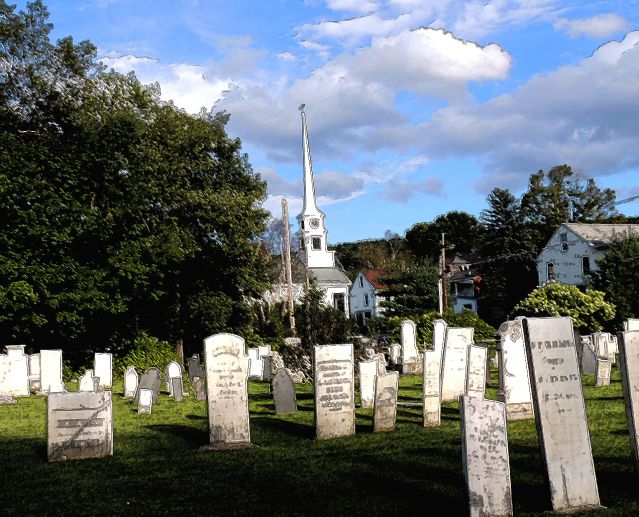Relationships
We've Got It Good
There are lots of stories in a Vermont graveyard
Posted September 1, 2013

What does a Vermont graveyard have to do with the quality of our lives in 2013? A few weeks ago I would have guessed the answer was “very little.” I don’t feel that way any more.
A cousin’s wedding brought us on a road trip to Vermont. We discovered what many have seen before us. It’s a beautiful state. The Green Mountains are particularly gorgeous. Even in the summertime when skiing is the farthest thing from anyone’s mind, the area surrounding Stowe is breathtaking. Admittedly, you have to look a little more deeply for the beauty, but it’s not hard to find.
It’s true that Stowe is a tourist area and the place is dolled up for tourists. But the one thing they can’t fake or put a Disney face on is the fact that the area is very old. It’s easy to forget that America’s history goes back nearly 250 years. Not very impressive by European standards, I’ll admit, but it’s what we’ve got. Back in the 18th century there were settlers in places like Stowe, Vermont, and they were trying to make a living (literally) without benefit of tourists from New York, Massachusetts and Quebec who come up for a dose of “quaint.”
Vermont wasn’t exactly the wild wild west but in some ways it might have been. There were no cops and supermarkets and shopping malls and take-out dinners and other conveniences of modern life. Vermont may not have been populated by the sociopaths who flocked to the old west, but not everyone in Vermont was lined up for the Good Neighbor award. And then there were injury and illness. If something happened to your child or partner you couldn’t just dial 911 and wait for help to come. Even if you could get a doctor to jump in his wagon and come over, he wasn’t likely to be of that much help. The average 12 year old today knows more about the causes of sickness than those 18th and early 19th century doctors did. That ignorance included septic complications from injury and childbirth. It’s a scary thought but whatever expertise your neighborhood sawbones brought with him did not include knowledge of microscopic pathogens. Understanding the role of germs in transmitting disease did not come until the late 19th century. Your family doc could do little more than hold your hand and watch your loved one die. He might talk somberly about “bad air” or, if you came from a really superstitious neighborhood, “evil spirits.” But that was the extent of his expertise. Can you imagine living like that? It’s like having an enemy all around you that no one can see, understand or stop.
Some of the people living in Vermont in the 19th century had pets and undoubtedly loved them as much as you love yours. But cuddly pets were a luxury. Cats in particular were there to keep vermin at bay. Nobody understood the way in which rodents might harbor disease, but almost everyone understood that having rats and mice scurrying around the kitchen was not a desirable situation. That’s where the cats came in. But if anything happened to your pet dog or cat, there was a limit to how many of the family’s precious resources could be diverted toward making her healthy again. Even if a family were sufficiently well off to spend lavishly to heal little Tabitha or big Rex, the state of veterinary medicine was no better than human medicine. Moreover, it was geared almost entirely to large (i.e. stock) animals. At the first sign of trouble, your family pet was more or less on his own.
Life was tough and relatively short under such unforgiving conditions. There were isolated cases of longevity but they were noteworthy. Not everyone was buried in a churchyard, but the one in Stowe stands in silent testament to changes in lifespan over the centuries. The 19th century markers in the Stowe yard revealed that Ebenezer Gillett made it to the ripe old age of 87. Asa Kimball died at 77 and his wife Orpha (that’s a name you don’t hear much anymore) made it to 67. But those three were all exceptions. Sarah Moody was gone just after her 43rd birthday and “Doc” James Taylor wasn’t saved by all his medical knowledge. He died in 1806 at age 27. Little Mary Ellen Warren died in 1853 a month and a half short of her seventh birthday. Her fate was far from unusual. The graveyard is littered with markers that simply say “baby” or “infant.” They died before they could be named.

What is the punch line from all of this is? At first I thought it was that even amidst this natural beauty, the harsh realities of day to day life went on for those living there. No one was immune despite the beautiful view from his back window.
But then a different message began to emerge for me. It is this: The next time you feel like complaining about losing the charger for your smart-phone or how hard it is to find Wi-Fi when you want to text that cute guy you met at your friend’s party, stop for a moment and think about how tough your life really is. Those people lying in the Vermont ground were just as real as you. They felt joy and fear. They experienced hunger and love. And they did it without smart-phones and 400 channels of TV or movies on demand. Most of the stuff you take for granted, even your leisure time, didn’t exist for them. In fact, they would have found just about all of it unimaginable. And we’re not simply talking about technology. It’s about the quality of life you take for granted.
Think about the Top 5 complaints in your life right now. Then imagine yourself talking to your counterpart back there in the 1840s. Same age, same gender. Magically risen from that Vermont graveyard just so you and she (or he) could compare notes. Maybe that imaginary talk will help you put it all in perspective the next time you roll your eyes and complain about how life sucks.
Thanks to Yana Hoffman
Images (c) Hank Davis


